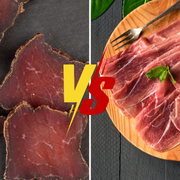
Cecina or Jamón: What's the Difference and Which Should You Choose?
When it comes to cured products, two names stand out in Spanish cuisine: cecina (cured meat) and ham . At first glance, they may seem similar, but they have very distinct characteristics, production processes, and flavors. If you've ever wondered what the difference is between cecina (cured meat) and ham , we'll explain it in detail in this article.
What is Cecina?
Cecina is a cured meat product traditionally made from beef , although it can also be made from horse, goat, or even rabbit. Its curing process is similar to that of ham, but its flavor and texture are completely different.
Origin and Production
Cecina is obtained from the hindquarters of the animal and goes through a process of:
- Salted: It is covered with salt for preservation.
- Washing: To remove excess salt.
- Settling: A period of rest under controlled conditions.
- Drying and smoking: The meat is exposed to oak or holm oak smoke, giving it a characteristic flavor.
The curing time can vary between 6 and 12 months , depending on the type of cecina.
Properties and Flavor
Cecina is characterized by:
- Intense flavor: Thanks to the smoking process.
- High protein content: It is an ideal food for healthy diets.
- Less fat: Compared to ham, cecina has a lower fat content.
- Firm texture: Not as fibrous as other cured meats.
What is Ham?
Ham is a signature product of Spanish cuisine and is obtained from the hind legs of pigs . There are two main types:
- Serrano Ham: It comes from white pigs and is cured for between 12 and 24 months .
- Iberian Ham: It is obtained from free-range Iberian pigs, with a curing process that can last up to 48 months .
Ham Making
The ham goes through a curing process that includes:
- Salted: It is covered with sea salt for preservation.
- Drying and maturation: In cellars with humidity and temperature control.
- Curing: The unique flavor and texture of the ham is developed.
Main Differences between Cecina and Ham
Although both are cured products, their differences are notable in several aspects:
| Feature | Dried meat | Ham |
|---|---|---|
| Origin | Beef (generally) | Pork |
| Part of the animal | Hindquarters | Hind legs |
| Healing | Between 6 and 12 months | Between 12 and 48 months |
| Flavor | Intense, slightly smoky | Soft and salty |
| Fat content | Low | Higher fat content |
| Texture | Firm and slightly fibrous | Unctuous and with fat veins |
Which to Choose: Cecina or Ham?
The choice between cecina or ham depends on your personal preferences:
- If you are looking for an intense flavor with less fat , cecina is ideal.
- If you prefer a juicier and more traditional option, ham is the best alternative.
Where to Buy Quality Cecina and Ham?
If you want to enjoy authentic Iberian ham or quality cured meat , we recommend:
- Gourmet stores: They offer products with certification of origin.
- Specialty supermarkets: Wide variety of options at affordable prices.
- Online stores: Platforms that allow national and international shipping.
Conclusion
Now that you know the differences between cecina and ham , you can choose the product that best suits your taste and needs. Both are delicious, with unique characteristics that make them exceptional options in Spanish cuisine.
Discover the Unique Flavor of Cecina and Ham!
If you want to enjoy authentic cecina or quality ham , check out our recommendations and choose the best one for you.
📌 Explore our options and try the best cured meat or ham today. Place your order now!







